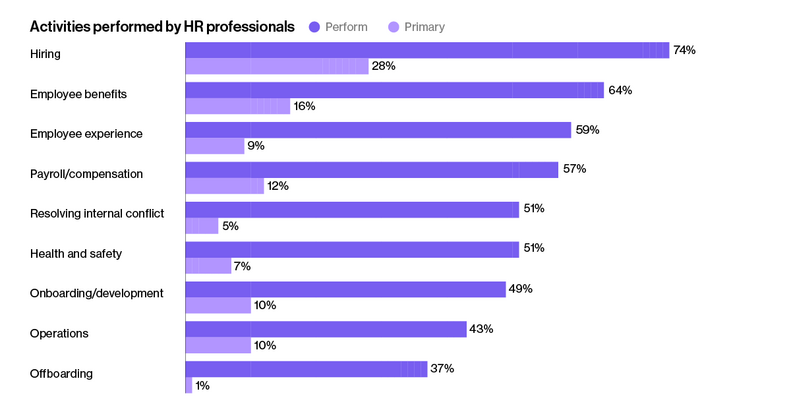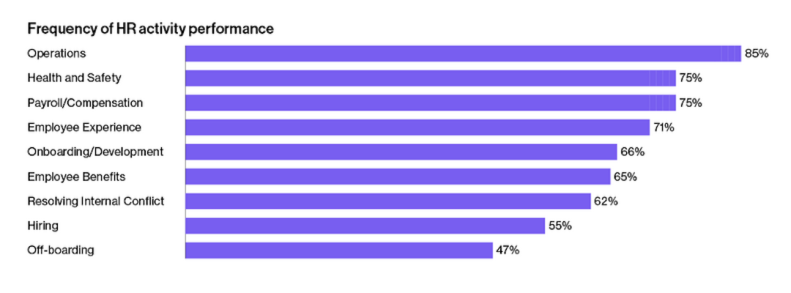2020 HR Technology Trends: Making Paperwork Less Manual

The foundation of any organization is its human resources. For any business to succeed and grow, it has to put effort into optimizing the talent from existing employees and finding the right new hires to complement that team. Human Resources teams accept this challenge but are faced with a daunting new one: building a system of HR tools that will allow them to efficiently manage those tasks.
To take a snapshot of the state of HR technology, an HR Trends 2020 research report was recently conducted. More than 800 key decision makers and influencers in HR functions globally were surveyed. The survey asked questions about the state of today’s HR teams, the technology they use and predictions about how the industry will change in the future.
The most striking finding of this research is that HR professionals are struggling to dedicate time to the work they see as most important. This is a problem that technology can solve. In this post, we’ll examine the results of the survey and suggest tools that will help HR teams move past current roadblocks.
HR professionals aren’t performing their primary tasks
By a large margin, respondents in the survey identify hiring as the most important aspect of their role. Hiring is both the most widely performed activity and the function most likely to be identified as respondents’ primary responsibility. Hiring is as likely to be an HR professional’s primary job function as the next two activities—employee benefits and payroll/compensation—combined.

Survey results show that HR efforts serve two primary audiences: new hires and existing employees. This makes sense. What is surprising is the extent to which those teams can be distracted by other tasks. Despite the importance of hiring and employee benefits, HR professionals are spending far more of their time on other activities. What are those other activities?
On a weekly basis, respondents are performing operations, health/safety and payroll/compensation tasks far more often than they are attending to their hiring and employee benefits responsibilities. Of the nine HR activities listed in the survey, hiring lands #8 of all tasks performed in a given week.

HR workflows are blocked by manual work processes
Why aren’t HR teams able to devote the time and resources to the tasks that they see as priorities? After seeing the discrepancy between the tasks that HR teams want to do and the tasks that HR teams are actually performing, answering that question became a main focus of the research.
The single biggest obstacle in HR workflows is repetitive document generation for agreements such as job offers and termination letters. Our respondents also indicated that they didn’t have sufficient time to do their primary tasks or access necessary resources.
Pressing further into complications with document generation, 75% of respondents still manage all or most of their agreements on paper rather than digitally. In fact, only 6% of respondents are currently using e-signature technology for all agreement paperwork. That’s astounding.
There’s an undeniable connection between HR teams that still utilize ink-and-paper agreements and those that report not having enough time to perform their priority tasks because of insufficient resources and repetitive document generation. Even though moving to an all-digital process would solve the most common barriers to HR success, respondents reported running into common obstacles during their transitions: cost/budget constraints (27%) and time to research, buy and implement new solutions (30%).
Unlocking HR teams from manual workflows
HR teams that continue to avoid digitizing paper processes are bound to run into the same time management issues year after year. More time wasted on repetitive document generation means less time spent on hiring and employee benefits work. Without technology to replace manual, error-prone processes, the gap between HR teams’ understood responsibilities and their actual labor investment will continue to expand.
Without the right HR tools in place, misallocated and underutilized resources will introduce more of the same problems that already exist in today’s landscape. These troubles create a vicious cycle for HR professionals. Without modern technology in place, it’s harder to attract the right talent and fill open positions. Without smooth integrations and automations, it will be harder to keep current employees satisfied and retained. Employee dissatisfaction will create new openings, which will be even more difficult to fill, etc.
Despite all of this, there’s good news: all of these problems can be solved with the right tools. A fully digital system of agreement eliminates the waste, error and delay that are part of current workflows, leaving HR teams free to focus on priority activities. This digital transformation increases productivity, reduces costs, and gives the team more flexibility to invest employee resources on activities that create new value for the organization.
Agreements are the core elements of the relationship between an organization and its employees. A modern, digital system of agreements supports the HR team in performing each of their key responsibilities. Digitizing paperwork helps HR prepare, sign, act on and manage agreements in an easy way to ensure that the HR team—and the organization at large—is operating at maximum productivity and efficiency. It’s also a great way to increase the satisfaction of every employee, which will in turn attract and retain top talent.
Unblock your HR teams from outdated processes.
Get the HR Technology Trends 2020 report.
